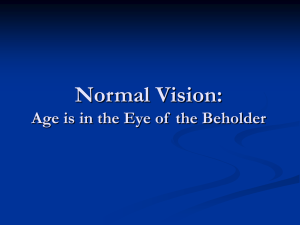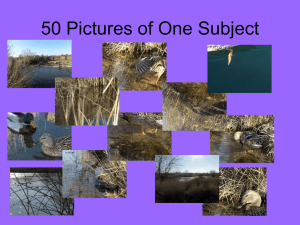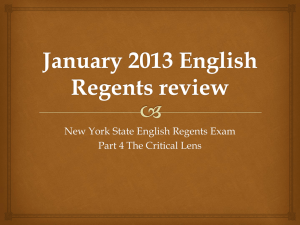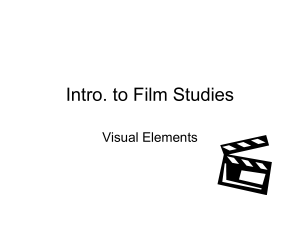Lecture 9
advertisement
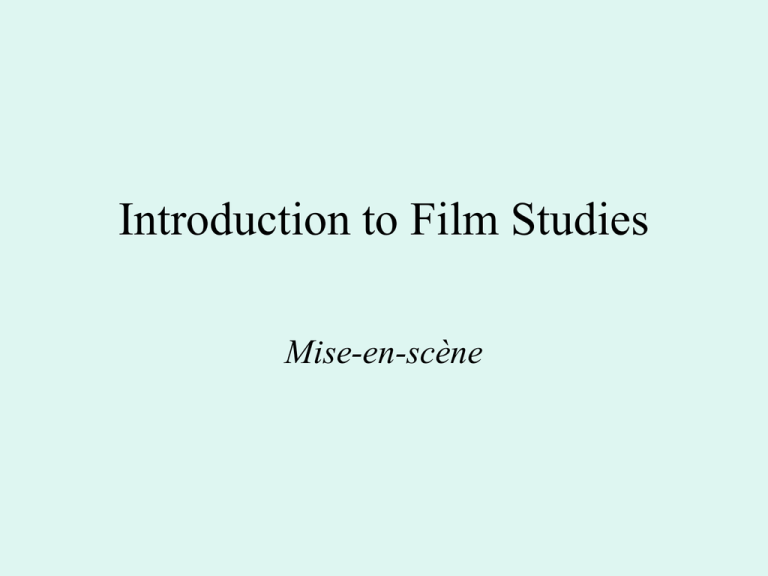
Introduction to Film Studies Mise-en-scène Perspective Relations • Types of camera lenses determined by their focal length – distance between the centre of the lens to the point where light rays converge on the film. Focal length of the lens can affect perspective relations in the things in a frame. Perspective Relations • Short focal length (wideangle) lens - A lens of less than 35 mm in focal length • Distort straight lines lying near the edges of the frame. • Two towers appear to lean rightward and leftward Nicholas Roeg’s Don’t Look Now Perspective Relations • Anything nearer the camera appear to bulge and its shape look distorted. • In Terry Gilliam’s Brazil a wide-angle lens is used extensively opening Perspective Relations • Middle focal length (normal) lens – A lens of medium focal length between 35 and 50 mm. • No noticeable perspectival distortion: horizontal and vertical lines are rendered straight and perpendicular • Depth does not look stretched apart or squeezed Perspective Relations • Long focal length (telephoto) lens - A lens of long focal length between 75 and 250 mm or more. • It flatten the space between what is in the foreground and in the background • The planes seem squashed together • Chen Kaige’s Life on a String Perspective Relations • In Godfrey Reggio’s Koyaanisqatsi an airport is shot from a great distance by a telephoto lens. The long lens makes the aeroplane look as if it were landing on a crowded motorway. 25.15 koyaanisqatsi Perspective Relations • Akira Kurosawa frequently used the telephoto lens. In his Red Beard a mad woman walks in a doctor’s room. It is filmed over the shoulder of the doctor and the distance between the two characters appears close at first. When they are shown sideways, the viewer would know that they are far apart. Perspective Relations • As the telephoto lens flatten depth, a figure moving towards the camera appears to take more time to cover what seems to be a small distance. • Running-in-place • Mike Nichols’ The Graduate Perspective Relations • Zoom lens – a lens which can change focal length and transform perspective relations within a single shot. • The zoom lens can substitute for moving the camera forward and backward, as it can magnify and de-magnify the subject. The Conversation The Lens: Depth of Field and Focus Depth of focus = the range before the lens within which objects can be photographed in sharp focus. A lens with a depth of field of 10ft (3m) to infinity renders any object in that range clearly, but anything outside it (e.g. in 4ft) goes out of focus. Lens: Depth of Field and Focus • A wide-angle lens has a relatively greater depth of field than does a telephoto lens. A scene from Orson Welles’ Citizen Kane – an example of ‘pan’ focus. All the people in this frame are in sharp focus. Lens: Depth of Field and Focus • Only one plane is in focus and the other planes are blurred – shallow focus. David Fincher’s Social Network (2010) A young man’s head in focus, another man in front slightly out of focus, and everybody beyond the central figure completely out of focus. A scene Lens: Depth of Field and Focus • Objects nearer to the camera are thrown out of focus, so that the viewer’s attentions is drawn to the sharper middle ground. • A popular visual style in the 1940s. • More recent example, Godfather (1972) Lens: Depth of Field and Focus • Selective focus can be used for a more abstract compositional effect. Leo Carax’s Boy Meets Girl (1984) I am what I am Lens: Depth of Field and Focus • Faster film stock, wider-angle lens, more intense lighting yield a greater depth of field. Deep focus photography, in which everything is in focus. In Citizen Kane Greg Toland achieved memorable deep focus photography. Lens: Depth of Field and Focus • Deep focus photography a popular stylistic choice in the 1940s and 50s. Samuel Fuller, Underworld USA (1961) The Girl Backed down Lens: Depth of Field and Focus • Deep focus photography revived in the 1970s • Spielberg’s films such as Jaws and The Close Encounters of the Third Kind Lens: Depth of Field and Focus • Perspective relations can be adjusted by using rack (racking) focus or pulling focus. One object is in focus in one plane and you rack focus so that another thing in another place, which was out of focus, come in focus. Wes Anderson’s Rushmore Swimming pool Framing Framing Framing Framing Framing effects the image by means of: (1) The size and shape of the frame (2)The way the frame defines on-screen and off-screen space (3) The way framing controls the distance, angle, and height of a viewpoint • • • • The shape of the frames On-screen space and off-screen space Distance, angle and height of the viewpoint Aspect ration = the ratio of frame width to frame height; 3 to 2 or 1.33:1 Framing • An early experiment to change the shape of a frame • Abel Gance’s ‘Triptych’, composed of three normal frames shot separately and combined side by side. • First attempt to create an wide, panoramic screen Framing • The Academy of Motion Picture Arts and Sciences established ‘Academy Ratio’ 1.33:1 in the 1930s • Standard worldwide until the mid-1950s Framing • A variety of widescreen ratios have dominated the 35 mm filmmaking since the 1950s • 1.85:1 in North America (Alien); 1.66:1 in Europe (Lancelot du lac) Widescreen format more frequently used in Europe than US, Robert Bresson’s Lancelot du lac (1974) Spirit of the lance Framing • A 2.35:1 aspect ration was standardized by the name of CinemaScope during the 1950s. • King Hu’s A Touch of Zen (1970) Bamboo Forest Framing • How to make a widescreen • Hard matte = To mask a frame at some stage in production or exhibition Framing • The imaged photographed squeezed horizontally by a special lens and another special lens unsqueeze the image during projection. Anamorphic lens and anamorphic process Framing • Emphasizing the horizontal expanse, widescreens were initially associated with spectacle genres – Westerns, travelogues, musicals, historical epics. • David Lean’s Lawrence of Arabia (1962) Framing (Composition) • Widescreen can be used for intimate drama as well. Kurosawa’s Read Beard creates a deep space photography with foreground, middle ground and background images. Framing (Composition) • Screen size and shape affect the frame composition. • The audience’s attention is drawn to one area of the image by putting important information slightly off centre. Framing (Composition) Divorce • Many scenes in Woody Allen’s Husbands and Wives fill the frame with bustle and movements shot in the hand-held camera. The audience’s attention shuttles around the frame according to who is speaking and who responds to the speaker. Framing (Matting) • The frame is normally rectangular. Filmmakers can change its shape by attaching masks over either the camera’s lens to block the passage of light. A circular mask is called iris, frequently used in silent cinema. ‘Circular’ dance in Abel Gance’s La Rou Masks in various sizes and shapes Mask reveals and hides: Buster Keaton’s Neighbors A girl for wedding but her wedding is not luxurious. Neighbors 12.00 Framing (Matting) • In D.W. Griffith’s Intolerance the frame is boldly blocked out to leave only a vertical line or diagonal line. Framing (Split screen) • Split-screen creates different frame shapes. Two or more different images, each with its own frame size and shape appear within the larger frame. Telephone conversation in Philips Smalley’s Suspense (1913) from Suspense Framing (Split screen) • The moment before guided missiles are launched is made more tense by splitting the frame into several images and giving the audience a good knowledge about what is going on. Robert Aldrich’s Twilight’s Last Gleaming Nuclear Weapon Framing (Off-Screen Space) • 6 off-screen spaces • The space beyond each of the four edges of the frame – left, right, top and bottom • The space behind the set • The space behind the camera Framing (OffScreen Space) • ‘Little Girl Lost’ is an episode in the American television series, Twilight Zone. In this episode a young girl has accidentally passed through a hole into another dimension. Her parents and friends try to locate off-screen and rescue her. Dark Dimension Framing (OffScreen Space) • Many characters appear and diverse actions take place in a scene, but some stay and some actions take place in off-screen space. In the opening scene of Hou Hsiao-Hsien’s City of Sadness (1989), a woman is delivering and people celebrating the end of the war off-screen while a man is praying on screen. childbirth Framing • Many characters appear and diverse actions take place in Hou Hsiao Hsien’s Good Bye South, Good Bye. The camera captures a group of people and move on to another group and action leaving behind people and actions in one scene. Indications of off-screen. Quarrel 24.00

